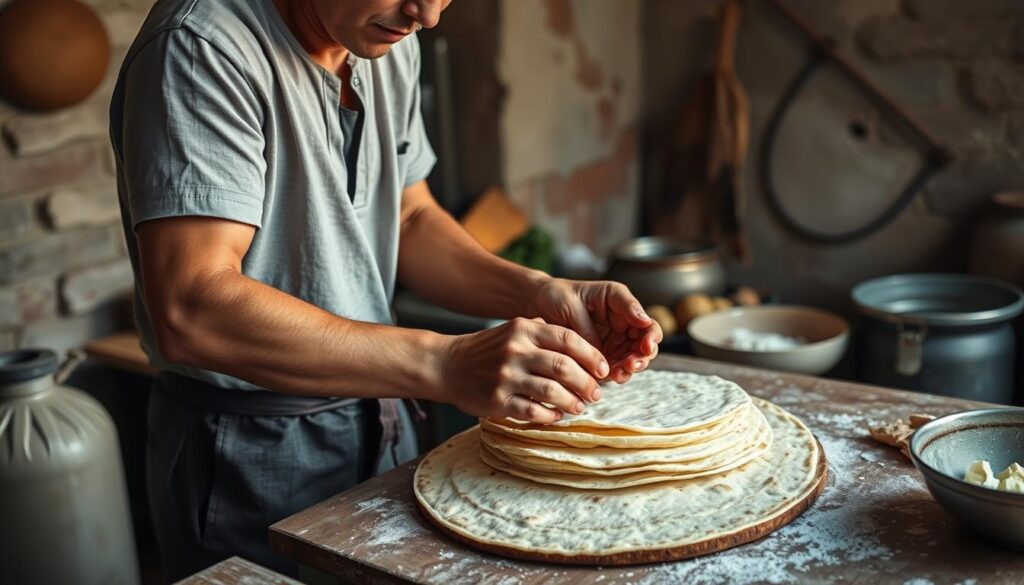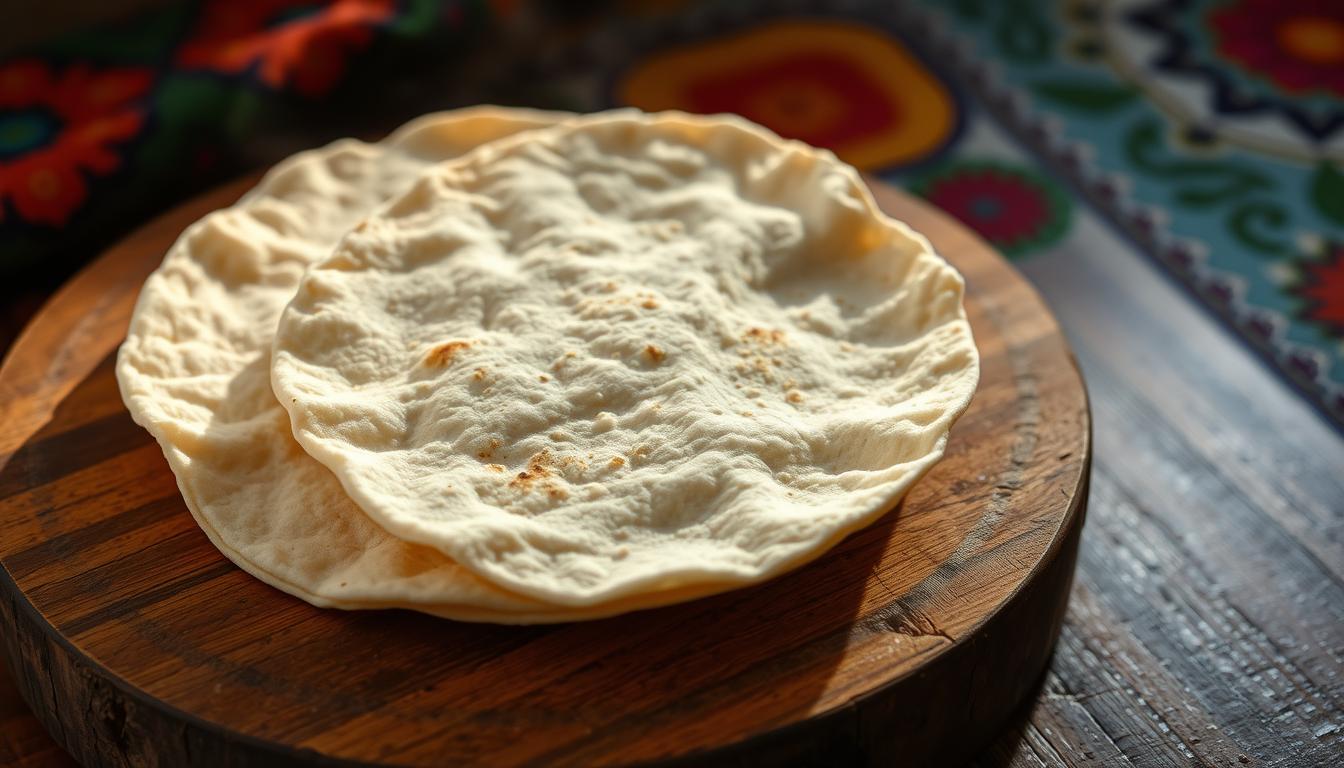How to make Mexican tortilla bread
Are you tired of store-bought tortillas that lack the authentic taste and texture of traditional Mexican cuisine? Imagine being able to create soft, pliable, and delicious flour tortillas at home, perfect for wrapping your favorite fillings.
You can achieve this with just four simple ingredients and a straightforward recipe. Homemade tortillas not only taste better than store-bought versions, but they also allow you to experience the authentic art of traditional Mexican cooking.
Key Takeaways
- Discover the simplicity of making authentic flour tortillas at home.
- Learn why homemade tortillas are superior to store-bought versions.
- Understand the cultural significance of tortillas in Mexican cuisine.
- Explore a comprehensive guide to making perfect tortilla dough.
- Elevate your home cooking with this staple Mexican bread.
The Magic of Homemade Flour Tortillas
There’s something special about creating your own flour tortillas from scratch, a process that’s both simple and rewarding. By making homemade tortillas, you’re not only enhancing your meals but also connecting with a rich culinary tradition.
Why Homemade Tortillas Beat Store-Bought Every Time
Homemade flour tortillas offer a freshness and taste that store-bought versions can’t match. By choosing your ingredients, you can ensure they’re made with the quality and care that reflects your personal touch. Here are a few reasons why homemade tortillas stand out:
- Customizable ingredients to suit dietary needs
- Freshness that’s hard to beat with store-bought options
- The ability to experiment with different flour recipes
A Brief History of Mexican Tortillas
Tortillas have been a staple food in Mesoamerican cultures for thousands of years, originally made from corn. The introduction of wheat by Spanish colonizers led to the development of flour tortillas, particularly in northern Mexico. Today, both corn and flour tortillas remain fundamental to Mexican cuisine, with each region offering its unique twist on traditional tortillas recipes.
Essential Ingredients for Perfect Mexican Tortilla Bread
To make authentic Mexican tortilla bread, you’ll need to start with the right ingredients. The quality of your tortillas depends heavily on the simplicity and freshness of the components used to make them.
Basic 4-Ingredient Recipe
The traditional recipe for Mexican tortillas includes just four main ingredients: flour, water, fat (such as lard or oil), and salt. The type of flour used is typically a fine, soft wheat flour, which provides the tortillas with their characteristic texture and flavor.
When it comes to the fat component, traditional recipes often call for lard, which is prized for its unique properties and flavor. However, you can also use other types of oil or even butter as substitutes.
Understanding Your Fat Options: Lard, Oil, or Butter
The choice of fat can significantly impact the taste and texture of your tortillas. Lard is the traditional choice for Mexican tortillas, offering a rich, nuanced flavor. It’s balanced more towards unsaturated fat, making it a cleaner option than some might expect.
While lard is preferred, you can also use oil or butter. Using different types of oil, such as vegetable or olive oil, can result in slightly different flavor profiles. For instance, olive oil can impart a fruity taste, while vegetable oil provides a more neutral flavor.

When choosing your fat or oil, consider not just the flavor, but also the nutritional content and how it affects the shelf life and reheating properties of your tortillas. For those looking for alternatives to lard, there are several options available, each with its own characteristics.
By understanding the role of each ingredient, you can better craft your tortillas to suit your taste preferences and dietary needs.
Equipment You’ll Need for Making Tortillas
To make delicious Mexican tortilla bread, you’ll need some basic equipment in your kitchen. The process of making tortillas from scratch involves several steps where having the right tools can make a significant difference in the outcome.
Essential Tools
The most basic tool you’ll need is a large mixing bowl for combining your dough ingredients. A measuring cup and spoons are also necessary for accurately measuring out your ingredients. For cooking the tortillas, a dry pan or griddle is essential; a cast-iron skillet works well for this purpose as it distributes heat evenly.
You’ll also need a rolling pin to roll out your tortillas to the right thickness. Some people prefer using a tortilla press, especially for corn tortillas, as it helps achieve a uniform thickness. However, for flour tortillas, a rolling pin is typically sufficient.
Nice-to-Have Accessories
While not strictly necessary, there are several accessories that can enhance your tortilla-making experience. A tortilla warmer is one such accessory; it allows you to stack cooked tortillas and keep them soft by trapping the heat and moisture. If you don’t have a tortilla warmer, you can use a pot with a cover that’s slightly larger than the tortillas.
Other useful accessories include a specialized spatula or turner for handling the tortillas while they’re cooking, and storage containers to keep your homemade tortillas fresh. Proper storage is key to maintaining the quality of your tortillas over time.
| Tool/Accessory | Description | Usefulness |
|---|---|---|
| Large Mixing Bowl | For combining dough ingredients | Essential |
| Dry Pan or Griddle | For cooking tortillas | Essential |
| Rolling Pin | For rolling out tortillas | Essential |
| Tortilla Warmer | Keeps cooked tortillas soft and warm | Nice-to-Have |
| Specialized Spatula/Turner | For handling tortillas during cooking | Nice-to-Have |
How to Make Mexican Tortilla Bread: Step-by-Step Guide

To make perfect Mexican tortilla bread, follow these simple steps that cover everything from preparing the dough to cooking the tortillas. The process involves a few key ingredients and some straightforward techniques.
Preparing the Dough
Start by combining 2 cups of flour, salt, and any desired fat (lard, oil, or butter) in a mixing bowl. Gradually add warm water to form a dough. The type of fat you choose can affect the flavor and texture of your tortillas. Mix until the dough comes together and is not too sticky.
Tip: Using the right type of flour is crucial. Opt for a fine, soft flour that’s suitable for making tortillas.
Resting and Dividing the Dough
Allow the dough to rest for at least 30 minutes. This resting period is crucial as it lets the gluten relax, making the dough easier to work with. After resting, divide the dough into small balls, about the size of a golf ball. You should end up with around 8-10 pieces, depending on the size you prefer for your tortillas.
Rolling Out Perfect Tortillas
Use a rolling pin to flatten each ball of dough into a thin circle. The goal is to make the tortillas as uniform as possible so that they cook evenly. If you have a tortilla press, you can use it to get the perfect shape and thickness.
Tip: Keep your work surface and rolling pin lightly floured to prevent sticking.
Cooking Techniques for Soft, Bubbly Tortillas
Heat up a comal or skillet to medium-high temperature. On my stove, 6 out of 9 on the big burner does the trick for these tortillas. Add the tortilla to the comal. Cook until you see bubbles forming. Ideally, this will happen in 45-60 seconds.
If it’s taking longer to bubble, raise the temp of the stove. If they are bubbling instantly, then lower the temp. When you flip it over, you’ll see some light brown spots. Perfect! Cook the opposite side for the same amount of time and set aside to cool.
Stacking freshly cooked tortillas helps them stay soft through steam retention. This technique ensures your tortillas remain pliable and ready to use.
Troubleshooting Common Tortilla Problems
Tortilla troubles got you down? Let’s fix that with some simple troubleshooting tips. Making tortillas can sometimes be a trial-and-error process, but understanding how to address common issues will get you back on track.

Why Are My Tortillas Tough?
Tough tortillas are often the result of overworking the dough. When you mix and knead the dough too much, the gluten develops, leading to a dense, tough tortilla.
To avoid this, mix your ingredients just until they come together, and knead the dough just until it becomes smooth and pliable. Also, be sure to let the dough rest for an adequate amount of time; this allows the gluten to relax, making the dough easier to work with.
Fixing Tortillas That Won’t Bubble
If your tortillas aren’t bubbling when cooked, it could be due to a few factors. First, ensure your skillet or griddle is hot enough; a hot surface is crucial for creating that characteristic bubble.
Another reason might be that the dough isn’t being rolled out evenly or thinly enough. Try to achieve a uniform thickness to promote even cooking and bubbling. If you’re still having trouble, check that your dough is at the right consistency – not too dry or too wet.
Dealing with Tortillas That Shrink When Rolling
When tortillas shrink back as you roll them out, it’s usually because the gluten hasn’t relaxed enough. Letting the dough rest for an additional 15-30 minutes can make a big difference.
Also, be gentle when rolling out the dough; applying too much pressure can cause it to shrink. “Patience is a virtue” when making tortillas; taking your time and not rushing the process will yield better results.
By addressing these common issues, you’ll be well on your way to making perfect tortillas every time. And remember, a few failed attempts are just part of the learning process – even experienced cooks had to start somewhere. With a bit of practice, you’ll master the art of making delicious, soft tortillas.
Storing and Reheating Your Homemade Tortillas
To keep your homemade tortillas fresh for a longer period, understanding the best storage and reheating methods is necessary. Proper storage ensures that your tortillas remain soft and pliable, ready for use whenever you need them.
Short-Term Storage Methods
For short-term storage, you can keep your tortillas at room temperature for up to 2 days. Wrap them in a clean kitchen towel or plastic wrap to maintain moisture. Alternatively, you can store them in an airtight container to keep them fresh.
Freezing Tortillas for Later Use
For longer storage, freezing is an excellent option. Place parchment paper between each tortilla to prevent them from sticking together, then store them in a freezer-safe bag or container. When you’re ready to use them, simply thaw at room temperature or reheat directly.
Best Ways to Reheat Tortillas
Reheating tortillas can be done in several ways. You can wrap them in a damp paper towel and microwave for 10-20 seconds. Alternatively, reheating them on a dry skillet over medium heat for a few seconds on each side can restore their pliability. The key is to reheat them for the right amount of time to keep them soft and fresh.
| Reheating Method | Time Required | Result |
|---|---|---|
| Microwave | 10-20 seconds | Soft and pliable |
| Dry Skillet | A few seconds per side | Restored flexibility |
| Oven | A few minutes | Warm and soft |
Delicious Ways to Enjoy Your Homemade Tortillas
You’ll fall in love with the versatility of your homemade flour tortillas. Not only are they perfect for traditional Mexican dishes, but they also open up a world of culinary possibilities. Use them for breakfast with scrambled eggs and a little red salsa, or turn them into wraps for lunch.
Some of your favorite recipes can be elevated with these incredible flour tortillas. Think fajitas, green chicken enchiladas, spicy vegetable burritos, and vegetable quesadillas. But why stop there?
You can also make fabulous, super thin crust pizzas by brushing them lightly with olive oil, topping with your favorite pizza ingredients, and baking in a piping hot oven at 450˚F for 4-5 minutes.
| Meal | Ideas |
|---|---|
| Breakfast | Breakfast burritos, migas |
| Lunch | Wraps, quesadillas, enchiladas |
| Dinner | Fajitas, tacos, burritos |
Experiment with different fillings and side dishes to complement your tortillas. You can also transform leftover tortillas into crispy chips or strips for soups and salads. The superior texture of your homemade tortillas makes them ideal for dishes where store-bought versions might fall apart.
Conclusion
Mastering the art of homemade flour tortillas opens up a world of culinary possibilities. By following the steps outlined in this guide, you’ve gained the skills to create delicious, authentic Mexican dishes that will impress family and friends.
Experiment with different fats and flour types to find your perfect recipe. Remember, the key to success lies in proper resting time, thin rolling, and correct cooking temperature.
With practice, you’ll be making flour tortillas like a pro, enjoying better taste, healthier ingredients, and cost savings. Make tortilla-making a regular part of your cooking routine and savor the satisfaction of creating something delicious from simple ingredients.







